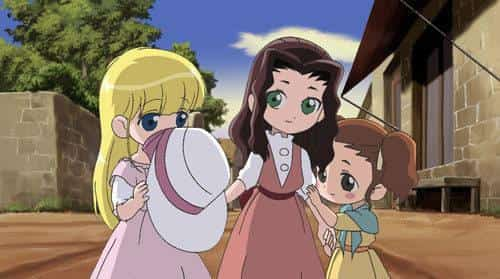The moving and fascinating story of "Les Miserables: Cosette": Anime review

"Les Miserables: Cosette": A moving animated version of Victor Hugo's classicBased on Victor Hugo's timeless masterpiece "Les Miserables," the anime "Les Miserables: Girl Cosette" is a 52-episode TV anime series that was broadcast in 2007. It is told from the perspective of the young girl Cosette. This work recreates the epic story of the original in the medium of animation, deeply moving viewers. Below, we will introduce detailed information and reviews of this work, as well as recommended points. Overview"Les Miserables: Cosette" was broadcast every Sunday from January 7 to December 30, 2007 on BS Fuji. It is a long series of 52 episodes, each 30 minutes long, that incorporates the essence of the original work while also allowing viewers to enjoy the anime's unique story development. It was produced by Nippon Animation and Fuji Television, and directed by Hiroaki Sakurai. storySet in revolutionary Paris, the story depicts the tense escape drama between Jean Valjean and Inspector Javert, who is pursuing him, as well as the beautiful love story between the young Marius and the grown-up Cosette. Fantine, the mother of young Cosette, comes from Paris with her and arrives in the village of Montfermeil in search of work, but is deceived by the Thénardiers and forced to leave her beloved daughter in their care. Fantine promises that she will "definitely come back for her someday" and begins working in the town of Montreuil-sur-Mer, but falls ill from the harsh conditions of the work. Jean Valjean (Madeleine), who inherits Cosette's wish, meets her, and so begins the fateful drama. Jean Valjean served 19 years in prison for stealing bread, and after his release he was still in a bad mood, but he regained his humanity after meeting Bishop Myriel. Using the false name Madeleine, he managed a factory in the town of Montreuil-sur-Mer and rose to the position of mayor. Meanwhile, Cosette was overworked as a servant for the Thénardiers, but she continued to live happily, believing in her mother's promise. Eventually, Jean Valjean and Cosette met, and the two began to walk the path of life together. characterThe main characters in this work are:
staffMany staff members were involved in the production of this work. The main staff members are introduced below.
Theme songs and musicThe theme songs and insert songs of this work are also one of its charms. The main songs are introduced below.
Evaluation and Impressions"Les Miserables: Cosette" is a work that deeply moved viewers by recreating the epic story of the original in the medium of animation. In particular, the story told from the perspective of the young girl Cosette made the profound theme of the original feel more familiar, and resonated with many viewers. In addition, while firmly incorporating the essence of the original, such as the bond between Jean Valjean and Cosette, the tense escape with Javert, and the romance with Marius, the anime also offers unique developments. The characters are also portrayed very carefully, with Cosette's growth, Jean Valjean's changes in humanity, and Javert's conflicts all depicted realistically. In particular, Nazuka Kaori's performance, portraying Cosette from her childhood to her adulthood, left a strong impression on viewers. Additionally, Sugawara Masashi's Jean Valjean and Matsuyama Takashi's Javert are faithful to the characters in the original work, while also bringing out the unique charm of anime. Music is also an important element in enhancing the appeal of this work. The opening theme "Kaze no Mukou" and the ending theme "Ma Maman" sung by Saito Yuki further deepened the moving story and left a strong impression on viewers. Additionally, the insert songs sung by Cosette, "Let's Meet in Our Dreams," "What I Can Do," and "Eternal Ring," also play an important role in expressing her feelings. Recommended points"Les Miserables: Cosette" is a moving animated version of Victor Hugo's masterpiece, and we recommend it for the following reasons:
Related TitlesThe following works are related to "Les Miserables: Cosette":
Conclusion"Les Miserables: Cosette" is a moving story that is an animated adaptation of Victor Hugo's masterpiece, and while it firmly incorporates the essence of the original work, you can also enjoy the unique development of the anime. The story is told from the perspective of the young girl Cosette, making the profound theme of the original work feel more familiar and resonating with many viewers. The careful portrayal of the characters and the moving music are also part of the charm, and will deeply move viewers. Please watch this work and enjoy the world of Victor Hugo's masterpiece. |
>>: The appeal and reviews of "Himawari!!": A cheerful and moving story
Recommend
Spider-Man: Far From Home has grossed over 600 million yuan in less than 72 hours since its release
Marvel's latest movie "Spider-Man: Far F...
A thorough review of the Aggressive Retsuko TV series! Explaining its appeal and recommended points
Aggressive Retsuko TV Series - A story about an o...
Beyblade Burst Sparking: An action-packed anime that sparks new battles
Beyblade Burst Sparking: New Sparks of Battle Bey...
The manga "Dangerous Things in My Heart" will be adapted into a TV animation and will be broadcast in 2023
The boys' love comedy manga "Dangerous T...
The appeal and reviews of KuruKuru Ami: Is it a new anime masterpiece?
Kurukuru Amy - Kurukuru Amy ■ Public Media TV ani...
Xu Zheng's "Lost in Russia" released a new trailer, the long journey of mother and son continued to laugh
Today (December 21), a new trailer for "Lost...
"The New King of Comedy" critical version trailer failed to double the career and family of the supporting actress
Stephen Chow's "The New King of Comedy&q...
The blood is burning again! The latest information on the new movie version of "Mobile Suit Gundam NT"
The latest theatrical animated film "Mobile ...
'0 Tester' review: A surprising experience that exceeds expectations
"Zero Tester": The appeal of 70s sci-fi...
Marvel legend declines, Avengers 5 director withdraws from project
Filmmaker Destin Daniel Cretton has stepped down ...
"The Meg 2" new trailer and poster Statham and Wu Jing are fully armed
Today (July 12), "The Meg 2: Abyss" off...
"Apex" is set! 60-year-old handsome old man Brad Pitt plays F1 driver
Recently, the F1 racing-themed movie "Apex&q...
Pixar releases 16-bit version of "Wall-E" short film to commemorate Earth Day
Today (April 23), to commemorate Earth Day, the f...
Is film dead? Tokyo Phenomenon announces cessation of operations
Tokyo Phenomenon and its parent company Toei anno...
"Barbie" released in 13 days, domestic box office exceeded 200 million yuan, total box office exceeded 780 million US dollars
According to Maoyan Professional Edition data, th...









